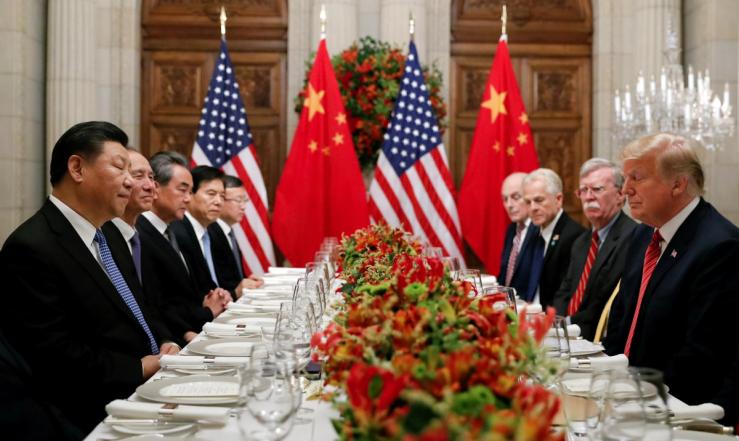Andy’s view
Inside the most complex machine mankind has ever devised, a laser beam hits a droplet of tin 50,000 times per second, generating temperatures 40 times those found on the surface of the Sun. This is just one part of the production process for advanced semiconductors. The almost science-fiction contraption, made by the Dutch firm ASML and heavily reliant on technology devised in the US, has come to symbolize the gap between China and the West.
Yet China has almost caught up.
Jensen Huang, the CEO of chipmaker Nvidia, says China is only “nanoseconds behind” in developing such advanced equipment. His assessment has big implications for US-China trade talks now underway.
So, despite the bellicose rhetoric often emanating from the White House and Capitol Hill, don’t be surprised if the two sides reach a pragmatic deal.
- For more analysis and insight on how China is changing the world, sign up for Semafor’s forthcoming China briefing.
China and the US are now so evenly matched that the Trump administration may decide it is better to figure out a way to cooperate in certain areas, including advanced technology, than to slug it out.
To apply military jargon to economic competition: Washington is losing its “escalation dominance,” meaning it can’t easily bully Beijing any more. China doesn’t just have the ability to soak up punishment from the US in the form of tariffs and sanctions — the culmination of decades of Chinese industrial policy aimed at self-reliance in core technologies. It also has the strength to strike back: Choking off the supply of rare earth magnets used in everything from cars to missiles soon brought US President Donald Trump back to the negotiating table with China after his “Liberation Day” tariff blitz.
Plenty of other examples abound. Huawei, China’s tech powerhouse, now competes head-on against Apple with smartphones powered by its own chips. A precocious Chinese startup, DeepSeek, came up with its own version of ChatGPT. BYD, the EV behemoth, now outsells Tesla in neutral markets like Europe. These and other made-in-China products — stealth fighters, humanoid robots, satellites — may not always be the best, but they’re good enough. That signals a tipping point.
Washington has plenty of incentive to collaborate with Beijing rather than risk confrontation. In certain technologies, China has not just caught up but pulled so far ahead the US may never be able to compete. Bloomberg reports that a group of American VCs who recently went on a road trip across China to look at factories and speak to startup founders were so awed by Chinese advances that they decided that key sectors in the West were now uninvestable. Yair Reem, a partner at Extantia Capital, thinks it is “game over” in batteries. Ford CEO Jim Farley sees China “completely dominating” Tesla, GM, and Ford in EVs.
Trump has already shown his pragmatic side by pulling off a deal to keep TikTok in business in the US. To get it done, he had to ignore an act of Congress, dismiss China hawks in both parties, and wave away concerns about national security. The result was a licensing arrangement in which TikTok’s Chinese owner kept possession of the all-important algorithm and a group of American investors managed the operation.
The licensing model is widely used by US pharmaceutical companies to gain access to cancer therapies now pouring out of Chinese labs. Ford even plans to license technology from Chinese battery leader CATL at a plant under construction in Michigan.
Ironically, this is how China got a lot of its technology from the US on its way to hollowing out swaths of American industry. Turning the tables on China by insisting on technology transfer as the price of investing in the US would be a smart move.
The US may have no real alternative.
In this article:
Know More
Some trade experts I speak with in DC are skeptical. They say it will be hard to reverse a precipitous decline in Chinese investments in the US even if Trump decides to open the door.
Chinese businesses in the US face a host of obstacles. Several states limit Chinese ownership of land and property. Communities mobilize against Chinese factories in their towns, even when they desperately need the jobs. Virginia Gov. Glenn Youngkin made clear that CATL isn’t welcome in his state, calling it “the face of the Chinese Communist Party.”
Then there are legitimate national security concerns. If the future of warfare is battery-powered drones, the US can’t be reliant on Chinese technology for batteries. Or for semiconductors. Tariffs on those products, combined with industrial policy to build domestic capacity, make sense.
Also, Trump had a compelling reason to save TikTok: It helped get him elected. He’s far less well-disposed to the green technologies where China is ahead.
Nor is it a given that the Chinese leader Xi Jinping will allow Chinese tech to flow across the Pacific to his chief geopolitical rival.
None of this rules out an agreement on Chinese investments in the US as part of a broader trade deal. It does suggest that any welcome for Chinese businesses will be selective. And it may take months, if not years, of grinding negotiations.
Room for Disagreement
Hal Brands, a US foreign policy expert, writes that great-power competition is fundamentally about technology. He believes that the US is still ahead (he cites American officials saying they have a two-year lead in advanced AI models, for example) but that its position is “perilous.”
Brands appears to believe the US has options for slowing China down. And he faults Trump for “gutting” policies that might achieve this. He is especially critical of Trump’s decision to shelve plans to tighten export controls on US-designed semiconductors. In his view, that move amounts to surrender.
Notable
- For more analysis and insight on how China is changing the world, sign up for Semafor’s forthcoming China briefing.


